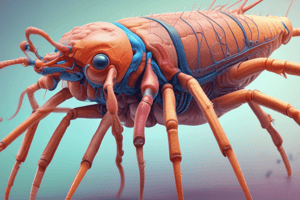Podcast
Questions and Answers
What is the primary focus of the study regarding Pediculosis capitis?
What is the primary focus of the study regarding Pediculosis capitis?
- The effectiveness of natural remedies for lice treatment.
- The impact of social factors on the spread of lice among students.
- The relationship between dietary habits and lice infestation.
- The effectiveness of lecture methods on improving knowledge and personal hygiene. (correct)
What research design was utilized in this study?
What research design was utilized in this study?
- Cross-sectional study.
- Quasi-experimental with one group pretest-posttest design. (correct)
- Retrospective cohort study.
- Longitudinal study.
Which factor is highlighted as a contributor to lice infestation in children living in hostels?
Which factor is highlighted as a contributor to lice infestation in children living in hostels?
- Frequent physical activity.
- High nutritional intake.
- Sleeping arrangements and poor personal hygiene. (correct)
- Access to educational resources.
What was the sample size used in the study involving children in the hostel?
What was the sample size used in the study involving children in the hostel?
What statistical analysis method was reported in the results of the study?
What statistical analysis method was reported in the results of the study?
Flashcards
Pediculosis capitis
Pediculosis capitis
A parasitic infestation of the head, commonly known as head lice.
Personal Hygiene
Personal Hygiene
Maintaining cleanliness and health-related habits of the body.
Socialization
Socialization
Process of educating community members about important topics through presentations
Quasi-experimental design
Quasi-experimental design
Signup and view all the flashcards
Statistical analysis
Statistical analysis
Signup and view all the flashcards
Study Notes
Effectiveness of Lecture Method Socialization
- Aim: To assess the effectiveness of a lecture method with PowerPoint on increasing knowledge and personal hygiene regarding pediculosis capitis in a hostel setting.
- Research Design: Quasi-experimental, one-group pretest-posttest.
- Sample: 41 female hostel residents.
- Intervention: Lecture method with PowerPoint presentation on pediculosis capitis and personal hygiene.
- Outcome Measures: Knowledge and personal hygiene scores before and after the intervention.
- Statistical Analysis: Marginal homogeneity test using SPSS 25.0.
- Significant Findings:
- A statistically significant increase in knowledge about pediculosis capitis (p<0.05).
- A statistically significant improvement in personal hygiene (p<0.5).
Factors Contributing to Pediculosis Capitis
- Predominantly affects hostel residents due to factors like shared sleeping arrangements and poor personal hygiene.
- Lice infestation is a significant issue, and treatment must be accompanied by knowledge to prevent reinfection.
- Personal hygiene is a critical factor in preventing infestation and spreading of pediculosis capitis.
- Sharing personal items such as hats, clothes, and combs facilitates spread between individuals.
Study Participants
- Age range: 12 to 17 years old.
- Educational level: 7th to 12th grade.
- Demonstrated varied age and education.
Knowledge Assessment
- Knowledge measured through online questionnaire validated by previous research (Fadilah, 2015; Hadi, 2018).
- Categorized knowledge as good, fair, or poor.
Personal Hygiene Assessment
- Measured before and after intervention.
- Evaluation of improvement level.
Intervention Success
- Intervention with Lecture method and PowerPoint proved statistically significant in both knowledge and hygiene improvements.
- Supporting evidence for the positive impact of educational intervention in this context.
Studying That Suits You
Use AI to generate personalized quizzes and flashcards to suit your learning preferences.





